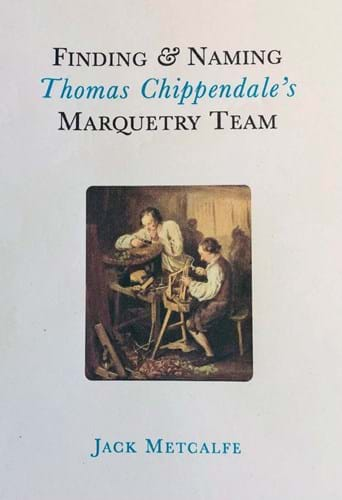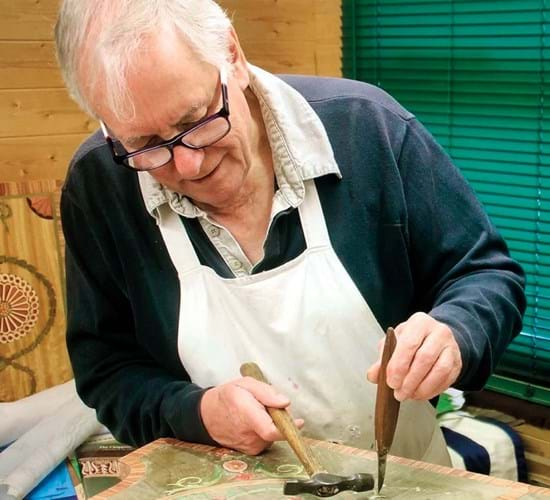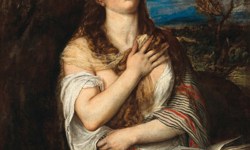Jack Metcalfe, who has over 20 years’ experience as a marqueteur, believes the same men did the marquetry for both Pierre Langlois and Thomas Chippendale. He names them as the English engraver JM Dutton and the German émigré John Zurn.
Metcalfe, who describes himself as “a practical man rather than an academic”, has published his lockdown research in a small hardback book titled Finding and Naming Thomas Chippendale’s Marquetry Team.
Detailed analysis
He was assisted in his study by John Russell and Thomas Lange, furniture conservators and researchers who work with Simon Phillips at Ronald Phillips. Two pairs of Langlois commodes previously owned by the London dealership are among the pieces discussed in the book.
Detailed technical analysis of furniture by both makers suggests the ‘inlayers’ who worked for Langlois (1718-67) on Tottenham Court Road in the 1760s were the same as those who produced marquetry furniture for Chippendale in St Martin’s Lane in the 1770s.
It has previously been shown by furniture historian Lucy Wood that, even after two stock sales, the Langlois shop continued to operate in some capacity for years after the proprietor’s death. The rates on the property were paid by his widow Tracey until 1773, by his son Daniel until 1781 and latterly by his son-in-law, the ormolu caster Dominique Jean, until 1786.

The front cover of Finding and Naming Thomas Chippendale’s Marquetry Team features a painting by Swedish artist Elias Martin that now hangs in the Swedish National Museum in Stockholm. It was painted by Martin (the nephew of the Anglo-Swedish cabinetmaker Georg Haupt) while in London c.1768-71. It shows two inlayers – one using a fretsaw at a bench, the other setting the veneers with a knife and hammer into a tabletop.
Metcalfe believes the Langlois shop effectively became a subcontractor to the Chippendale workshop. As the first Chippendale marquetry furniture dates from just after Langlois’ death (the earliest documented piece is a games table delivered to Nostell Priory in 1769), the timing is certainly correct.
The knowledge that some of Chippendale’s work was made off-site or subject to a joint working arrangement also helps explain some well-known anomalies in the great maker’s output.
Famously, for example, the marquetry door panels to the library writing table at Harewood House were made 1cm too big and were trimmed to fit with the loss of some scrollwork as a consequence.
Tantalising references
Very little English period furniture is signed or labelled in the way that was common in continental Europe (and much less is mentioned in original order books and receipts).
However, Metcalfe has found tantalising references to the two men he believes were responsible for the inlaying work.
The name of JM Dutton (listed at the time as an engraver) has been found on two Langlois commodes in the Royal Collection while a ‘Mr Zurn’ signed a pair of marquetry commodes at The Vyne, Hampshire. Their work matches perfectly that seen on later pieces from the Chippendale workshop.
According to his trade card, Langlois, a cabinetmaker of Huguenot origin, specialised in the marquetry decoration of “all sorts of fine cabinets and commodes, clock cases, secretaires, ecoignures et autre meubles”. A key figure in the introduction of French style to English furniture (he may have trained under Jean-Francois Oeben in Paris), he was producing marquetry furniture in London from as early as 1759. Ince and Mayhew made marquetry furniture from the mid-1760s.
Some of the first research on the Langlois workshop was published by the late Peter Thornton and Bill Rieder in 1971-72. Lucy Wood added to the history of the firm in her article New Light on Pierre Langlois published in the Furniture History Society Newsletter in 2014.
Metcalfe’s latest book is intended as an addendum to Chippendale’s Classic Marquetry Revealed (published to mark the tricentenary of Chippendale’s birth in 2018) which includes an analysis of the once vibrant colours used for inlaying Georgian furniture.
All royalties from the sale of the book go to Motor Neurone Disease charities.















